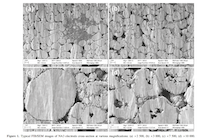Ask for a reprint
email :
* Give your email
2020
ACL
|
S.J.Tambio, F.Cadiou, E.Maire, N.Besnard, M.Deschamps, B.Lestriez, 'The concept of effective porosity in the discharge rate performance of high-density positive electrodes for automotive application with the diffusion-limited penetration depth model.', J. Electrochem. Soc., 167 160509 (2020) doi:10.1149/1945-7111/abcb42
The electrochemical performance of NMC532-based electrodes designed for the EV application were measured between 0 and 40°C. The results were compared to the predictions of the electrolyte limited penetration depth model [Gallagher et al., J. Electrochem. Soc. 163, A138 (2015)], also called limited diffusion current density model [Heubner et al., J. Power Sources 419, 119 (2019)]. To support this analysis, we took into account the actual microstructure of the electrodes, previously characterized by FIB/SEM tomography, and their measured and/or simulated transport properties. We show that the power performance of NMC532 electrodes, even with a low carbon content below the percolation threshold, are not limited by electron transport due to the high intrinsic conductivity of this material. At 40°C, the swelling of the PVdF by the electrolyte solvents penalizes performance, especially as the binder content is high. Above all, the current density at which a brutal decrease in capacity occurs is well predicted by the model, although by reducing the porosity to its percolated micrometer fraction. This is in good agreement with the numerical simulations of the properties of ionic transport.
|

|